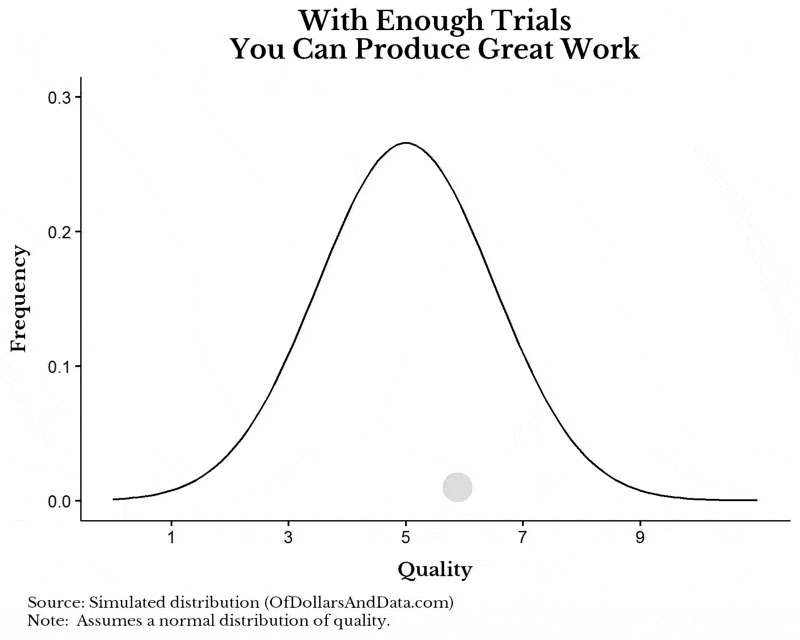Having a creative career is like dynamite. The only thing you need to do is ignore how long the fuse is.
This post is for all the people who want to make a name for themselves through writing, acting, music, art, or some other creative endeavor where you need “luck” to succeed. Though I cannot predict what level of success you will achieve, I am telling you that you can succeed, if you try long enough.
When I first started blogging I was under the impression that success in blogging, or any other creative outlet, was based solely on the quality of the work being produced. If I wrote great posts I would get success, and if I didn’t I would fail. Now I have come to realize that success in any creative outlet has far more to do with quantity and consistency than quality. This is not to say quality doesn’t matter, but, if you can reach a certain level of quality in your work, your success will be based on the quantity of work you produce. Therefore, creative success is a numbers game. Let me explain with a simple example.
Most of the time when you play a lottery your payout is negative. You pay $1 to win, on average, less than $1. Let’s imagine a scenario that is the opposite of this, where you pay $1 to win, on average, more than $1. I will call this a positive lottery. A hypothetical example of a positive lottery could be the following:
Imagine I have a bag that contains 99 red balls and 1 green ball. If you pull out the green ball you get $100, but if you pull out a red ball you get nothing. The fair price to play this game is $1, as, with enough trials, your average payout will be $1 and you will be no worse off than when you started. But what if I sold you the right to play this game for $0.50? Now the expected value is greater than the price you paid. Therefore, with enough draws from the bag, you will make money.
Positive lotteries don’t exist in real life, at least not for long. However, creative pursuits are very much like positive lotteries. The problem with individuals pursuing creative professions is that many give up before they get the chance to reap the rewards. Imagine the same game above with the green and red balls, but I only charged you $0.01 to play. You would be silly to give up after pulling a few red balls out of the bag right? In fact, on average, it would take you 100 draws before you got the green ball, but this would only cost you $1 (100 * $0.01). However, when you did get the green ball, you would win $100!
How is this related to success in a creative field? Everything.
In the creative space you usually have to tire at some craft for a while (i.e. months, years, or longer) before being discovered and making a career out of it. So the defining factor is not a matter of if, but a matter of when. Another way to think about your creative pursuit is like dynamite. As I mentioned above:
Having a creative career is like dynamite. The only thing you need to do is ignore how long the fuse is.
A dynamite career can blow up at any time, but no one can predict how long it will take. This is the nature of creative success. More importantly, most people give up while they are still “burning their fuse”. It’s just like the lottery before the green ball.
A more formal definition was put forth by one of my favorite authors, Nassim Taleb, in his book Antifragile. The definition of antifragility is anything that gains from disorder. Instead of a fragile package that says “Handle with care”, Taleb asks his readers to imagine a package that says “Please mishandle”. In Greek Mythology, the hydra would grow back two heads for every one that was chopped off, thus, gaining from harm. This is antifragility.

Creative careers are completely antifragile because randomness (i.e. luck) usually brings positive outcomes. Many times happenstance and random events end up giving most creative artists their “big break”. And the more exposure you get to these random events the more benefits these will bring. If we compare this with fragile careers (i.e. a typical 9–5 job like my own), you will see that the dynamics are not the same. Despite the higher initial income with a 9–5 job compared to a creative career, there is limited upside. Your boss won’t one day “discover you” and hand you a check for a $1,000,000.
This highlights one more incredibly important point about antifragile careers. Antifragile careers are defined by many small losses (i.e. I am still waiting for Paul Krugman to retweet me) and a few very large gains (i.e. 90+% of my views are due to 4 influential investors sharing my work). You can think of these small losses as having little to no cost (i.e. no cares if no one retweeted you). However, when one of these little bets pays off, the outcome is massively positive. This reminds me of why Spike Lee said he never feels bad asking for money: You only need one yes.
This brings me back to my argument on quality near the beginning of this post. I completely agree that not everyone can succeed if they don’t meet some basic quality threshold in their creative work. However, if your average work is above this threshold, then you just need to keep pulling from that distribution. Some of your work will be good, some will be great, and some will fail, but, on average, you should succeed with enough trials. I would even argue that as you produce more quantity your quality increases to a degree.
To visualize the random quality of your work, I put together an animation showing random draws from an imagined distribution of quality (i.e. 1–10). Draws in the middle occur more frequently as they represent average quality work, draws from the right, though rare, represent high quality work, and draws from the left, equally rare, represent lower quality work. There is no guarantee that the distribution of your quality has to look like this, but this should be instructive of what it could look like over time. Each red circle represents one piece of work you might produce:

As you can see, the circles are clustered around the center where the biggest hump of the distribution is located. More importantly, if you draw from this distribution long enough, you can create some great quality work.
Lastly, quality is hard to predict before hand, so spending lots of time creating your magnum opus might be wasted. For example, on this blog I have zero predictive power over what will take off and what won’t. Just Keep Buying has over 20,000 views, while I have other posts with less than 500 views, and I do not know why. I know my quality varies, but does it vary that much? Or is it luck? Or something else? There is a great story about Pablo Picasso’s Bull’s Head sculpture where he welded handle bars to a bike seat on a whim. Today it is one of his most well known sculptures despite the fact that it took no planning.
Consistency is King
If you still don’t believe me, consider the many examples of creative artists attributing their success to consistency/quantity:
- Casey Neistat, a Youtube star, summarized how 3 words got him 3 million subscribers: Just Keep Uploading.
- Shaunta Grimes, a top writer on Medium, wrote about how she grew her views and subscribers dramatically by posting to Medium daily instead of less frequently.
- Originals: How Non-Conformists Move the World, by Adam Grant, makes a similar argument about the positive relationship between quantity and creative success.
This reminds me of a great post about the invention of branding by Morgan Housel. My favorite part was this line:
The best way to build a powerful brand is to be good all the time rather than great some of the time
For all of you out there making good work all the time, stay the course and thank you for reading!
If you liked this post, consider signing up for my newsletter.
This is post 20. Any code I have related to this post can be found here with the same numbering: https://github.com/nmaggiulli/of-dollars-and-data

